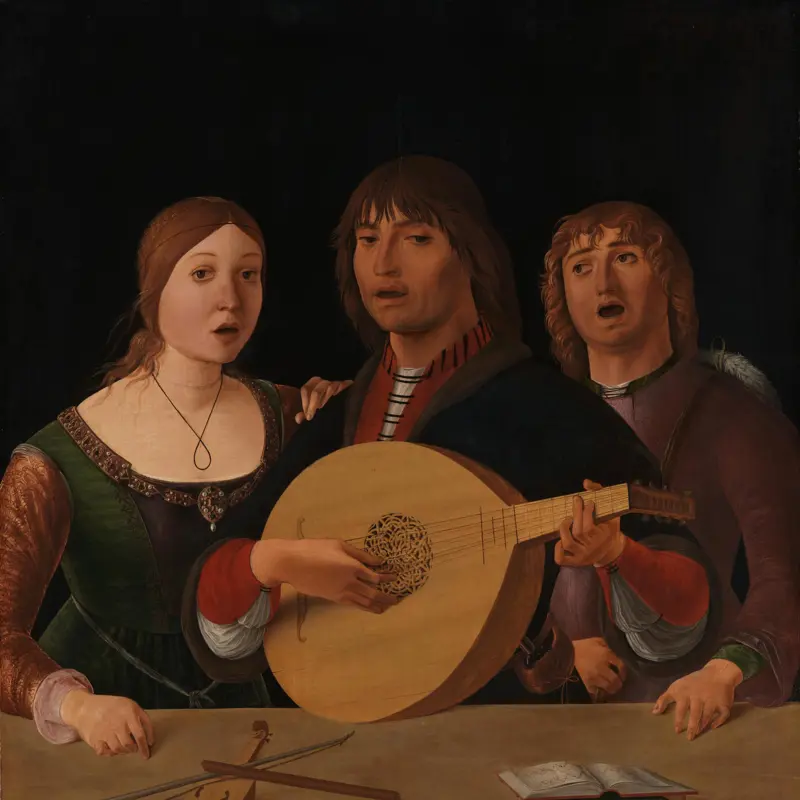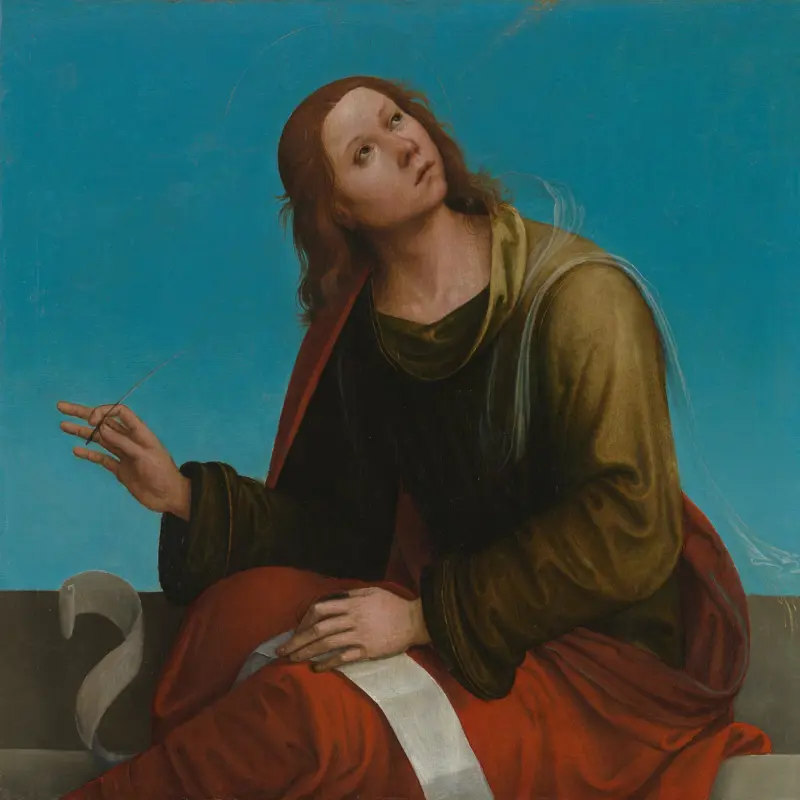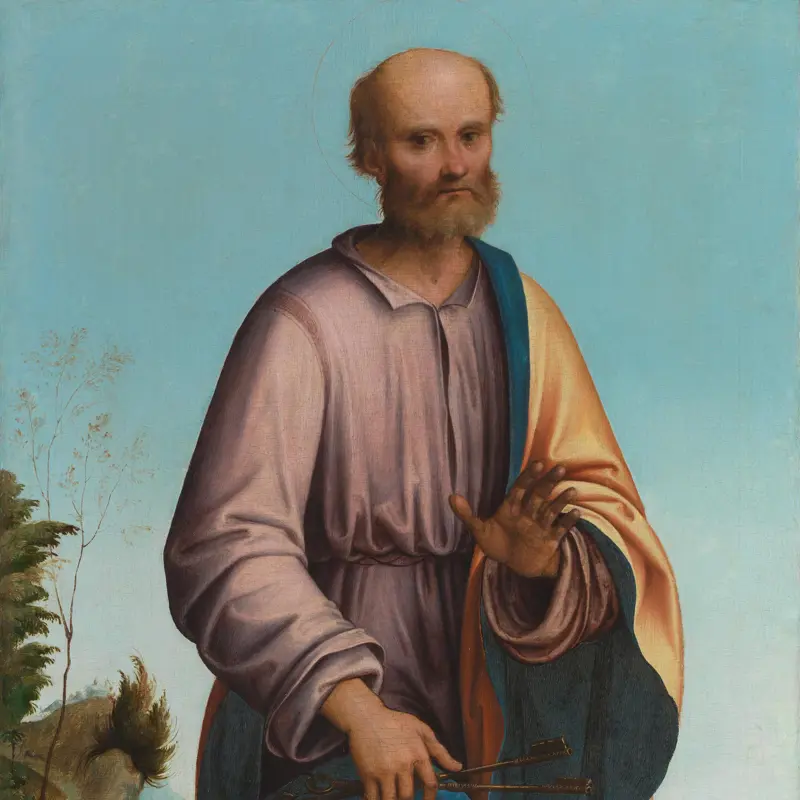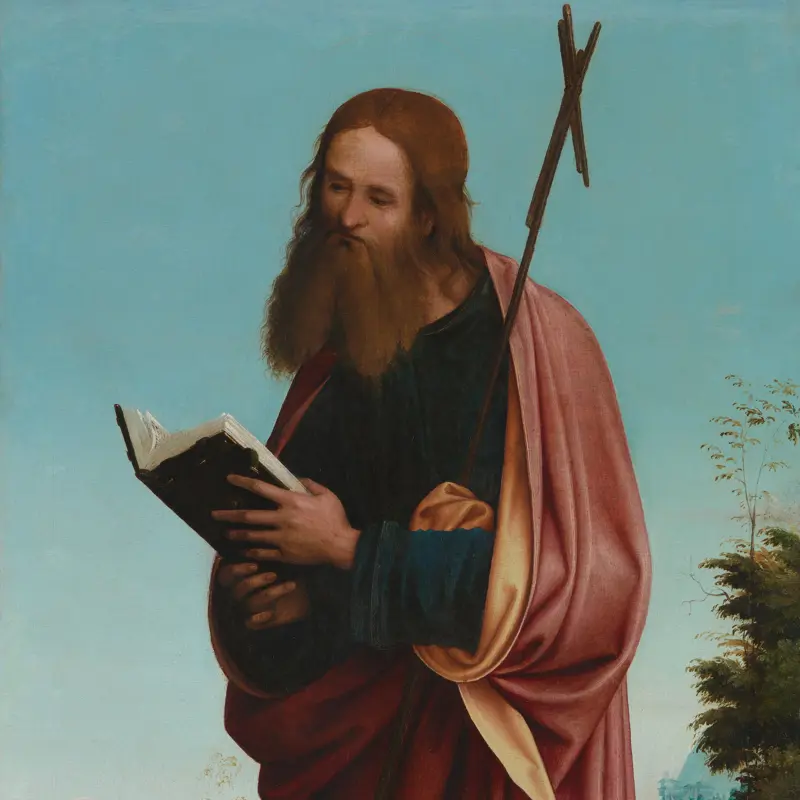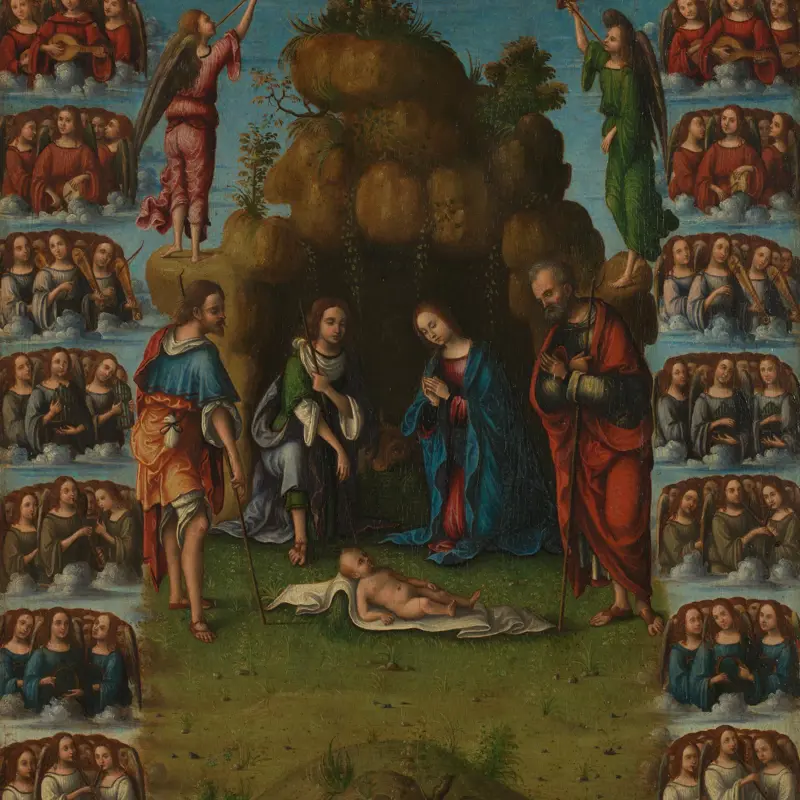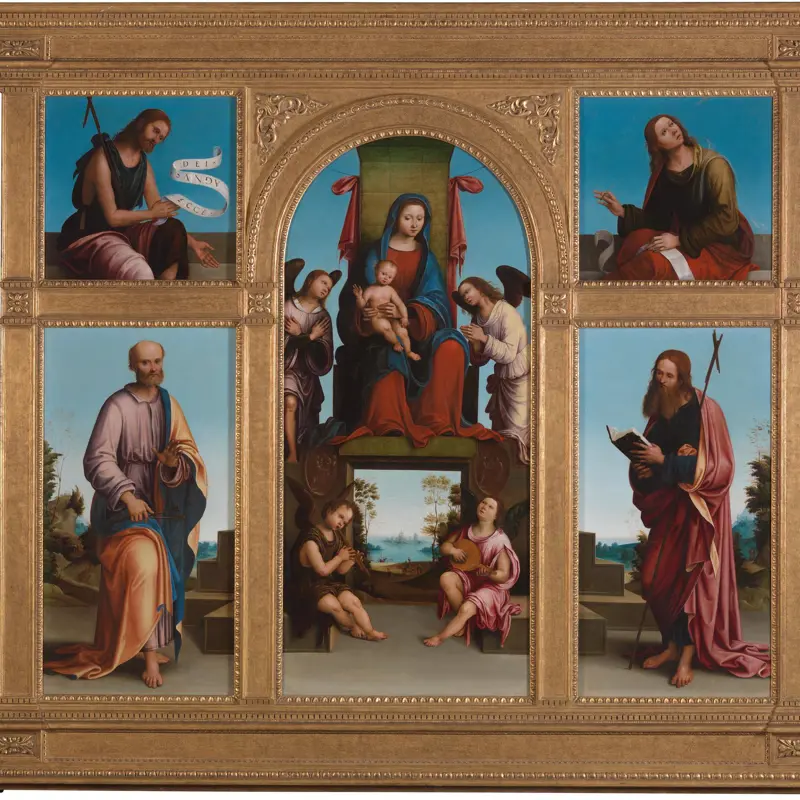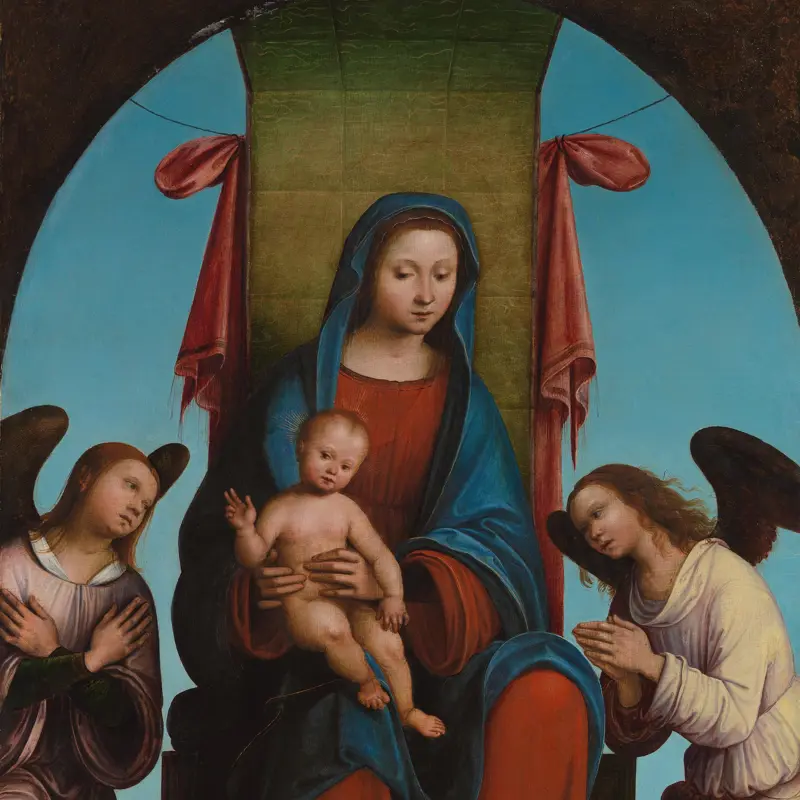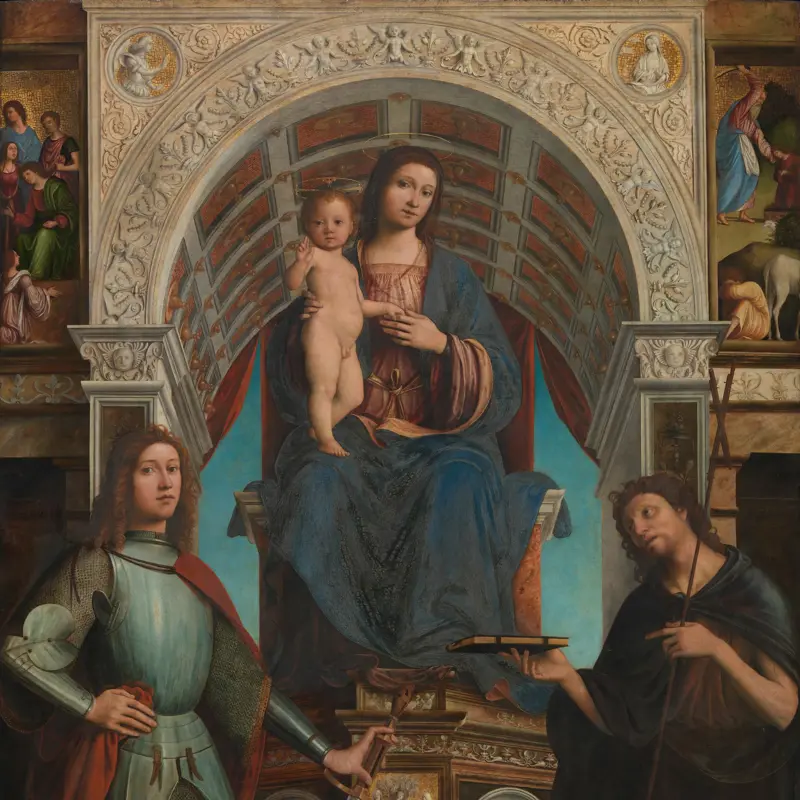Lorenzo Costa, 'Portrait (supposed to be of Battista Fiera)', about 1490-5
About the work
Overview
The man in this portrait appears to have just turned away from the darkness surrounding him to take a look at us. His lips are slightly parted as though he might speak.
An inscription on the back of the panel names him as Battista Fiera, doctor at the court of Mantua as well as a poet, though we can’t be sure it’s him. Costa had become court artist in 1506 and the painting was once thought to have been made when their two residencies coincided. But the way that Costa has given shape and three-dimensionality to the man’s features is much closer to his painting style in the 1490s.
Fiera was interested in the city’s artists and artistic projects. He mentioned Mantegna (Costa’s predecessor as court artist) in a poem about the best way to represent the concept of justice in painting, and also wrote about his admiration for Costa.
Key facts
Details
- Full title
- Portrait (supposed to be of Battista Fiera)
- Artist
- Lorenzo Costa
- Artist dates
- 1460 - 1535
- Date made
- About 1490-5
- Medium and support
- Oil on wood
- Dimensions
- 51.4 × 38.7 cm
- Acquisition credit
- Bequeathed by the Misses Cohen as part of the John Samuel Collection, 1906
- Inventory number
- NG2083
- Location
- Room 14
- Collection
- Main Collection
- Frame
- 15th-century Italian Frame
Provenance
Additional information
Text extracted from the ‘Provenance’ section of the catalogue entry in Giorgia Mancini and Nicholas Penny, ‘National Gallery Catalogues: The Sixteenth Century Italian Paintings’, vol. 3, ‘Bologna and Ferrara’, London 2016; for further information, see the full catalogue entry.
Exhibition history
-
2011The Renaissance Portrait: from Donatello to BelliniBode-Museum25 August 2011 - 20 November 2011The Metropolitan Museum of Art21 December 2011 - 18 March 2012
Bibliography
-
1885A. Luzio and R. Renier, 'Contributo alla storia del mal francese', Giornale storico della letteratura italiana, V, 1885, pp. 408-32
-
1894F. Harck, 'Ausstellungen und Versteigerungen: Burlington Fine Arts Club, London', Repertorium für Kunstwissenschaft, XVII, 1894, pp. 312-9
-
1894A. Venturi, Exhibition of Pictures, Drawings & Photographs of Works of the School of Ferrara-Bologna, 1440-1540, London 1894
-
1895Catalogue of Pictures by Italian Masters of the Fifteenth, Sixteenth, Seventeenth and Eighteenth Centuries, Collected by John Samuel, London 1895
-
1897G. Gruyer, L'art ferrarais à l'époque des princes d'Este, Paris 1897
-
1903J. Cartwright, Isabella d'Este, Marchioness of Mantua, London 1903
-
1907M.H. Spielmann, 'The John Samuel Bequest to the National Gallery, I', The Connoisseur, XVII, 1907, pp. 229-34
-
1907M.H. Spielmann, 'The John Samuel Bequest to the National Gallery, I', Revue de l'art, XXI, 1907, pp. 161-76
-
1911E.G. Gardner, The Painters of the School of Ferrara, London 1911
-
1934R. Longhi, Officina ferrarese, Rome 1934
-
1957J. Wardrop (ed.), De Iusticia Pingenda: On the Painting of Justice. A Dialogue between Mantegna and Momus by Battista Fiera, London 1957
-
1958C. Dionisotti, 'Battista Fiera', Italia medioevale e umanistica, I, 1958, pp. 401-18
-
1962Gould, Cecil, National Gallery Catalogues: The Sixteenth Century Italian Schools (excluding the Venetian), London 1962
-
1962E. Faccioli (ed.), Mantova: Le lettere, Mantua 1962
-
1967R. Varese, Lorenzo Costa, Milan 1967
-
1970C. Brown, 'Lorenzo Costa in Mantua. Five Autograph Letters', L'arte, 1970, pp. 106-17
-
1975C. Gould, Delaroche and Gautier: Gautier's Views on the 'Execution of Lady Jane Grey' and on other Compositions by Delaroche, London 1975
-
1977C.M. Brown, Lorenzo Costa, Ann Arbor 1977
-
1977P. Tosetti, 'Lorenzo Costa', University of Padua: Annals of the Faculty of Arts and Philiosophy, II, 1977
-
1979A. Braham, The National Gallery Lends: Italian Renaissance Portraits (exh. cat. York City Art Gallery, 3 March - 16 April 1979; Nottingham Castle Museum, 21 April - 3 June 1979), York 1979
-
1981R. Jones, 'What Venus Did to Mars: Battista Fiera and Mantegna's Parnassus', Journal of the Warburg and Courtauld Institutes, XLIV, 1981, pp. 193-8
-
1981J. Mills and R. White, 'Analyses of Paint Media', National Gallery Technical Bulletin, V, 1981, pp. 66-7
-
1981National Gallery, 'Pictures Cleaned and Restored in the Conservation Department of the National Gallery, January 1981 - December 1981', National Gallery Technical Bulletin, VI, 1982
-
1981D. Chambers and J. Martineau, Splendours of the Gonzaga, (exh. cat. Victoria and Albert Museum, 4 November 1981 - 31 January 1982), London 1981
-
1986R. Lightbown, Mantegna: With a Complete Catalogue of the Paintings, Drawings and Prints, Oxford 1986
-
1987Gould, Cecil, National Gallery Catalogues: The Sixteenth Century Italian Schools, London 1987
-
1987A. Ugolini, 'Lorenzo Costa da Bologna a Mantova', Prospettiva, XLVIII, 1987, pp. 79-85
-
1988C.T. Perina, 'La pittura a Mantova nel Cinquecento', in G. Briganti (ed.), La pittura in Italia: Il Cinquecento, Milan 1988, vol. 1, pp. 95-104
-
1992B. Fiera, Coena: Delle virtù delle erbe e quella parte dell'arte medica che consiste nella regola del vitto, Mantua 1992
-
1992D. Chambers, J. Martineau and R. Signorini, 'Mantegna and Men of Letters', in J. Martineau (ed.), Andrea Mantegna, London 1992, pp. 8-30
-
1992K. Christiansen, 'The Studiolo of Isabella d'Este and Late Themes', in J. Martineau (ed.), Andrea Mantegna, London 1992, pp. 418-26
-
1993R. Signorini, Il monumento celebrativo di Andrea Mantegna a Mantova, Mantua 1993
-
1994S. Ferino Pagden, Isabella d'Este: Fürstin und Mäzenatin der Renaissance (exh. cat. Kunsthistorisches Museum, 13 February - 24 May 1994), Vienna 1994
-
1995G. Agosti, 'Su Mantegna, 4: A Mantova nel Cinquecento', Prospettiva, LXXVII/1, 1995, pp. 58-83
-
1999H. Anderson, Collecting, Connoisseurship and the Art Market in Risorgimento Italy: Giovanni Morelli's Letters to Giovanni Melli and Pietro Zavaritt (1866-1872), Venice 1999
-
2001
C. Baker and T. Henry, The National Gallery: Complete Illustrated Catalogue, London 2001
-
2002E. Negro and N. Roio, Lorenzo Costa, 1460-1535, Modena 2002
-
2003M. Spring, R. Grout and R. White, '"Black Earths": A Study of Unusual Black and Dark Grey Pigments used by Artists in the Sixteenth Century', National Gallery Technical Bulletin, XXIV, 2003, pp. 96-114
-
2006R. Signorini and D. Soglianis, A casa di Andrea Mantegna: Cultura artistica a Mantova nel Quattrocento, (exh. cat. Casa del Mantegna, 26 February - 4 June 2006), Milan 2006
-
2016Mancini, Giorgia, and Nicholas Penny, National Gallery Catalogues: The Sixteenth Century Italian Paintings, 3, Bologna and Ferrara, London 2016
Frame
This is a fifteenth-century Italian frame. Crafted from poplar wood, the frame features an architrave moulding. It retains the original gilding, which is heavily worn. The punch-tooled frieze is decorated with intricately carved undulating vines adorned with trefoil leaves, stylised buds and flowers. These organic elements are linked by tied volutes at the central points of both the upper and lower edges.
The frame was acquired in 2010, and retains its original form.
About this record
If you know more about this work or have spotted an error, please contact us. Please note that exhibition histories are listed from 2009 onwards. Bibliographies may not be complete; more comprehensive information is available in the National Gallery Library.

